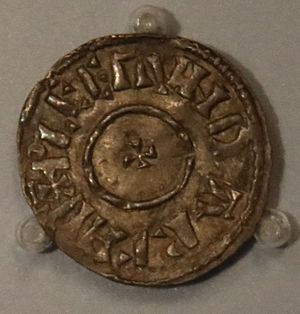Plegmund facts for kids
Quick facts for kids Plegmund |
|
|---|---|
| Archbishop of Canterbury | |

Coin of Plegmund in the Ashmolean Museum, Oxford
|
|
| Appointed | 890 |
| Reign ended | 2 August either 914 or 923 |
| Predecessor | Æthelred |
| Successor | Athelm |
| Orders | |
| Consecration | 890 |
| Personal details | |
| Died | 2 August either 914 or 923 |
| Sainthood | |
| Feast day | 2 August |
| Venerated in | |
| Canonized | Pre-Congregation |
Plegmund (who was also called Plegemund) was an important English church leader in the Middle Ages. He became the Archbishop of Canterbury in 890. Some people believe he lived as a hermit (someone who lives alone for religious reasons) before becoming archbishop.
As archbishop, Plegmund helped change and improve the church. He worked with other smart people to translate important religious books. After he died, he was made a saint.
Contents
Early Life and Learning
We don't know much about Plegmund's early life. We do know he came from a region called Mercia. A story from much later says that Plegmund lived as a hermit in a place called Plemstall.
Plegmund was known for being a very smart scholar. This caught the attention of King Alfred the Great. King Alfred wanted to bring back learning and education to his kingdom. So, before 887, King Alfred asked Plegmund to join his royal court.
There, Plegmund worked with three other scholars. They helped translate a famous book called Pastoral Care by Pope Gregory the Great. They changed it from Latin into Old English, which was the language spoken at the time.
Becoming Archbishop
King Alfred chose Plegmund to be the Archbishop of Canterbury in 890. The Anglo-Saxon Chronicle, a very old historical record, says that Plegmund was "elected by God and all the people."
There was a short time between the death of the previous archbishop and Plegmund's appointment. This might have been because another scholar, Grimbald, was offered the job first but said no. Plegmund received his pallium (a special woolen scarf given by the Pope) from Pope Formosus.
Reorganizing the Church
In the 9th century, the church in Canterbury was not as strong as it used to be. One of Plegmund's main jobs was to make it strong again. To do this, he created new church areas, called "sees" or "dioceses."
Between 909 and 918, he created four new sees within the existing Diocese of Winchester. These new areas were in Crediton, Ramsbury, Sherborne, and Wells. This meant that each main area of Wessex (a powerful kingdom) would have its own bishop.
- The Bishop of Crediton was for Devon and Cornwall.
- The Bishop of Ramsbury was for Wiltshire.
- The Bishop of Sherborne was for Dorset.
- The Bishop of Wells was for Somerset.
- The Diocese of Winchester remained for Hampshire.
To make these changes, Plegmund needed approval from Pope Sergius III. This Pope had cancelled some of the actions of the earlier Pope Formosus. So, in 908, Plegmund traveled all the way to Rome. He went to get his pallium again and make sure his changes were approved. He was the first Archbishop of Canterbury to visit Rome in almost 100 years! When he came back, he brought with him some relics (special objects) of Saint Blaise.
Working with Kings
During Plegmund's time as archbishop, the quality of Latin writing improved a lot. The people who copied books for him wrote much better than those who worked for the previous archbishops.
When King Alfred died in 899, Plegmund had an important role. He crowned Alfred's son, Edward the Elder, as the new king.
Plegmund also helped with government matters. He attended important meetings held by King Edward the Elder in 901, 903, 904, and 909. In 909, he also dedicated the tall tower of the New Minster church in Winchester.
Death and Saintly Status
Plegmund died on 2 August. Historians are not sure if it was in 914 or 923. After his death, Plegmund was seen as a saint. His special day, or feast day, is celebrated on 2 August. However, people didn't start celebrating him as a saint until the 13th century.

